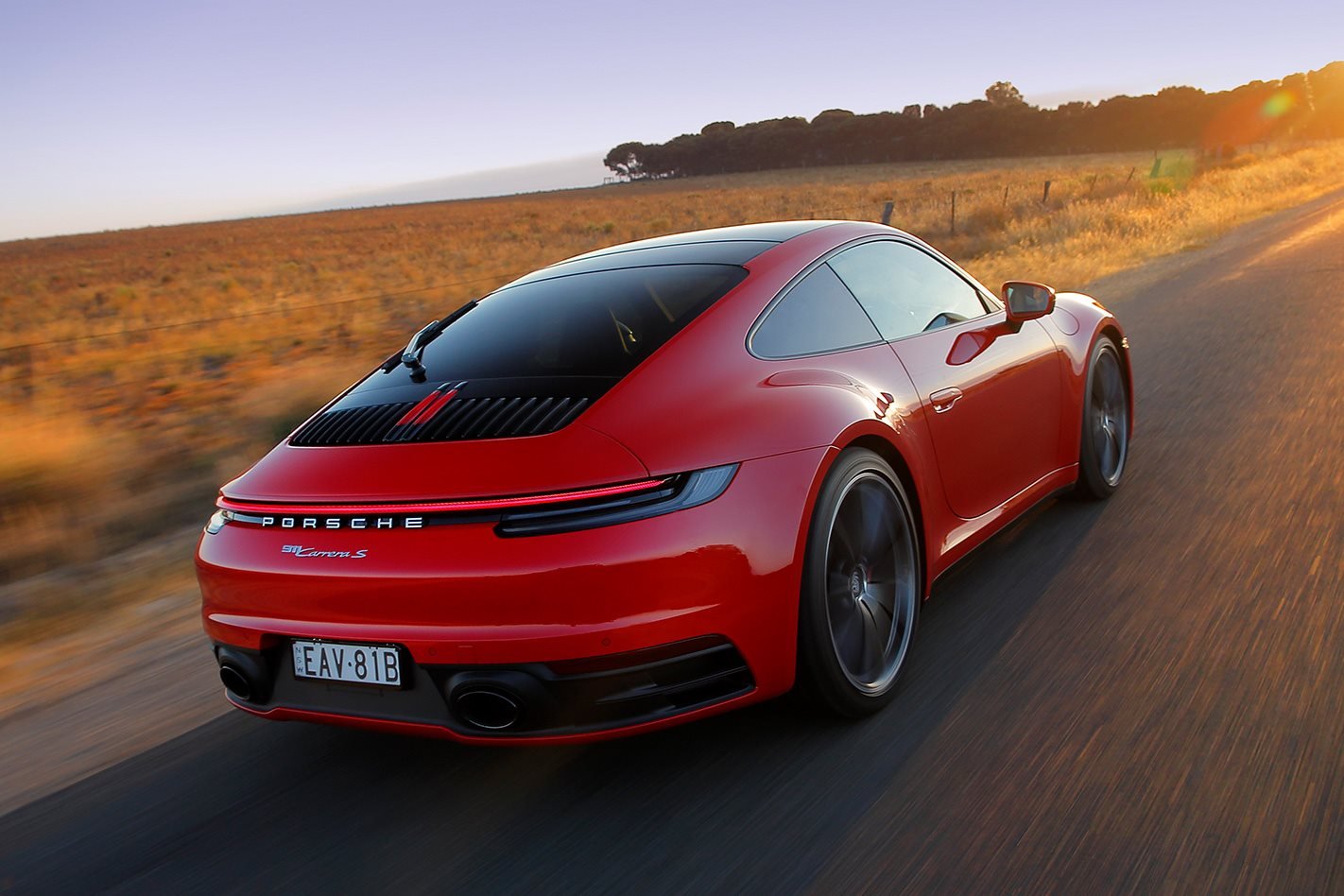Overall Rating

5 0 5
Plus & Minus
WHAT IS THE PORSCHE 911 CARRERA S?
At the moment the Carrera S is the only 992 that Porsche is importing. That’s 331kW and 530Nm of twin-turbo 3.0-litre flat six which, in itself, is a fairly remarkable output, identical in power to the 959 hypercar. Zuffenhausen offers the car in coupe guise – which we’re driving here – or as a Cabriolet. Both come with a new eight-speed PDK twin-clutch transmission, although a seven-speed manual will be offered later. Also on its way is a base Carrera for those who find $265,000 for a Carrera S or $281,100 for a Carrera 4S (the all-wheel drive variant) a bit too rich for their blood.
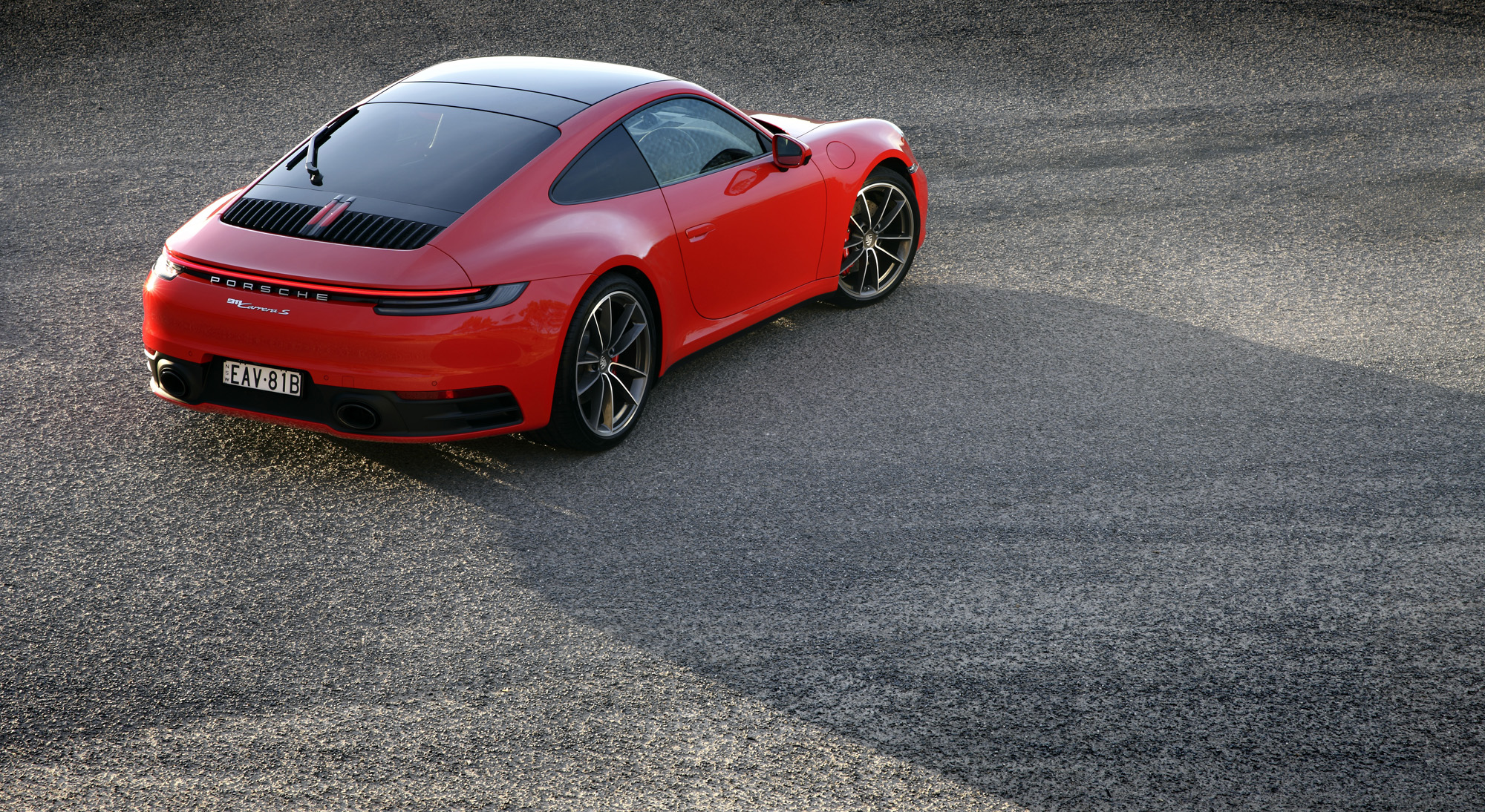
WHY WE’RE TESTING IT
So much of the 992 is new that there’s no way that we can think of it as a ’991.3’. Body, chassis, suspension, transmission, a lot of the engine, interior – it’s all new.
PORSCHE 911 CARRERA S REVIEW
Typical lazy Porsche. That’s what you were probably thinking when you saw the first press shots of the 992 version of the iconic 911. It didn’t look that different and, to be honest, did it really need to be that different? The 991 developed into a great car, especially in later 991.2 guise (from 2016) and most figured the 992 would be a gentle evolution designed to see the 911 through to a more radical update that included a chassis designed to handle a big battery pack as well as an engine at the back.
That’s what we all thought. Porsche clearly wasn’t listening though.
It has, in many instances, made the most of incremental gains – the odd one percent here and there that add up in totality, but if there’s one area where the car has made a giant leap forward, it’s in ride quality, more of which later.
It’s worth stressing just what a blisteringly rapid car the Carrera S is. The rear-drive car gets to 100km/h in 3.7 seconds, with the 4S managing a quicker 3.6s. Opt for the Sport Chrono pack, which includes active engine mounts, and that figure drops to 3.5s for the Carrera S and 3.4s for the Carrera 4S. That latter figure is quicker than a 997 GT2 RS. It’s as quick around the Nurburgring (7m25S) as a 991 GT3.
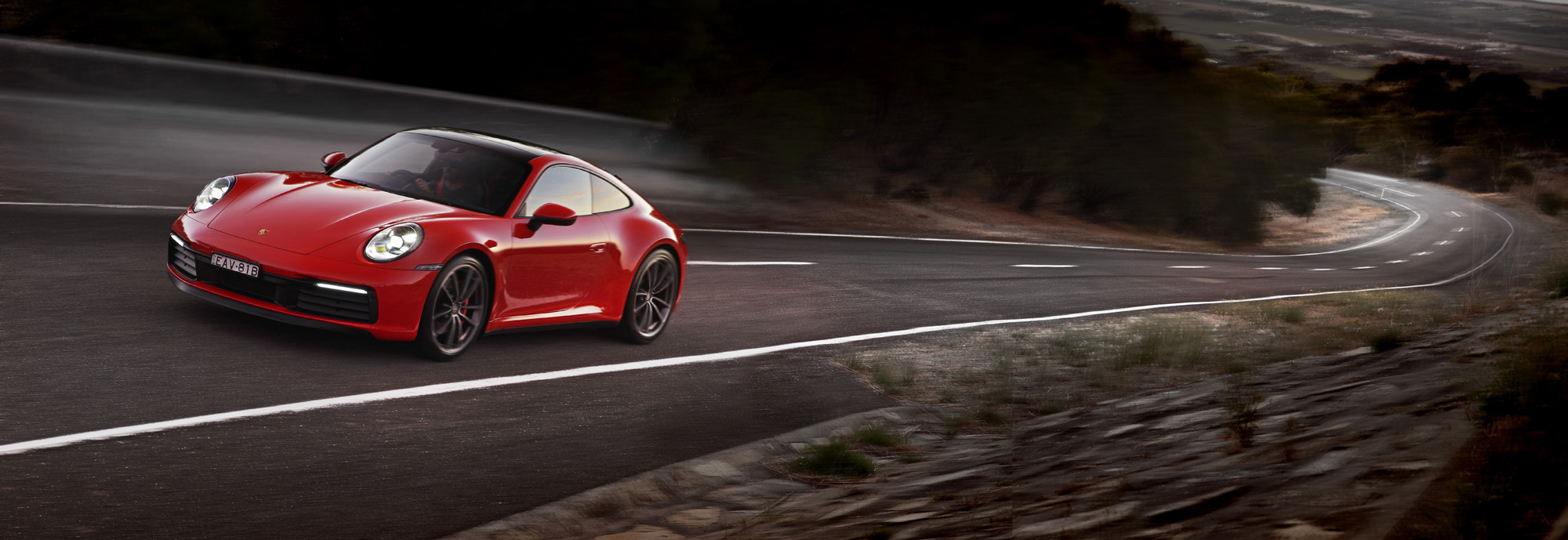
Again, it’s easy to be underwhelmed if you just glance at figures. After all, 331kW is the same as the old Carrera GTS and the weight of the car has crept up. Rear wheel drive cars are now around 85kg heavier than their predecessors. Delve deeper and the engineering behind this car is absolutely intriguing. I hope you don’t mind me exploring a few of these advances in detail before we jump into driving impressions, but it’s worth understanding the philosophy behind the development of this car because it signals a key departure in the evolution of the 911.
Let’s open with the body-in-white, the bones of the car. Where the 991 was comprised of 63 percent steel, the 992 is down to 30 percent high tensile steel. Virtually every body panel you see is aluminium, with boron steel used for areas like the rollover structures. Despite being 20mm longer, 4mm taller and a smidgeon wider than the 991, the body is five percent lighter and a whopping 11 percent lighter than 997, despite all 992 bodies being wide-body shapes with voluptuous Coke-bottle flanks. Buyers apparently want ‘em wide.
Easing out the dimensions slightly, improving crash protection, fitting the eight speed transmission as well as bigger brakes, wheels and tyres have increased overall weight, but it’s a bargain worth making. A lot of weight could come out of these cars if required. All Carrera S models have either a sliding or a glass sunroof and the comfy electrically adjustable seats have to be 50kg heavier than a carbon-shelled bucket seat that’ll go into a future GT3 version.
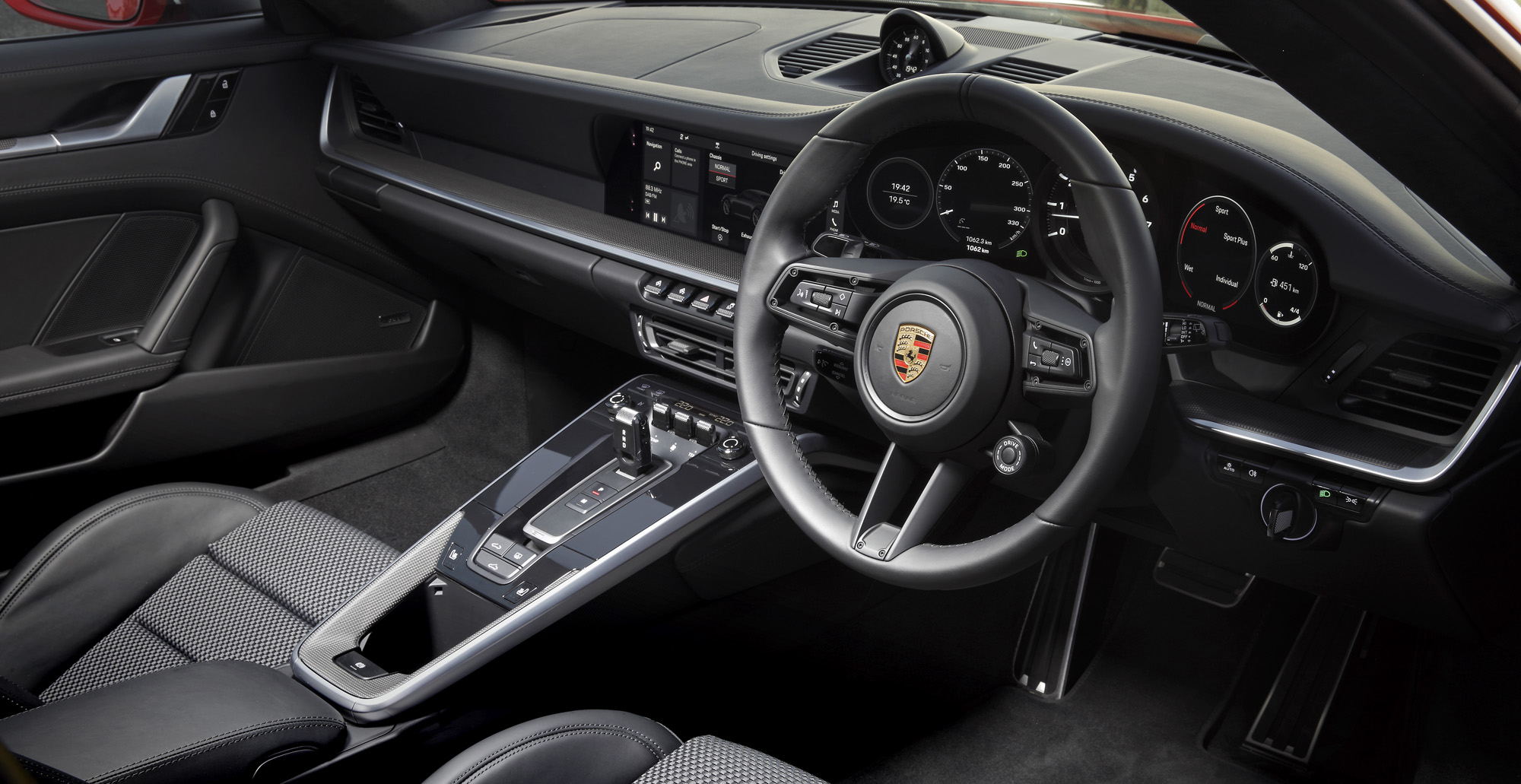
The engine, you’ll be unsurprised to hear, is still slung out back, but it’s attached to the car in a very different way. Whereas the 991’s lump was narrowly mounted by a pair of bolts to a small subframe, Porsche learned a lesson from the 718 Boxster/Cayman and realised that the wider apart the two mounting points are, the smaller the mechanical advantage the engine can wield as it’s subjected to enormous pitch, roll and tilting forces. Therefore the engine is now mounted further forward and uses the opposing cylinder heads to clamp it in place. The upshot of that is that by controlling the engine’s masses better, ride quality can be softer when required or firmer when necessary.
The block is much the same as before, but virtually everything on the top end of the engine has changed. The valvetrain is particularly intriguing and again, Porsche has borrowed ideas from other cars in its stable. In this case, it’s the 3.6-litre V6 from the Panamera, which utilises the two intake valves asynchronously. One valve opens early and by a tiny amount to induce swirl in the cylinder, the second valve then opens fully, the new piezo injectors (borrowed from diesel engines – seeing the theme?) firing up to five squirts of fuel per cycle into a swirling layer cake of air. At higher engine loads, both valves open fully to tumble big volumes of air more conventionally.
There’s been a fundamental redesign of the turbochargers too. By operating the two bigger turbos in a contra-rotating fashion, the ducting to them can be symmetrical rather than the convoluted route leading off one bank in the 991. That idea came from group hot-in-vee V6s and V8s. Electrically operated wastegates now allow the catalysts to get hot during cold starts more efficiently and are part of an ongoing process of gradually excising hydraulic and vacuum-operated actuations in the car. That’s borrowed from Porsche’s hybrid tech where things often need to move without any engine power at all.
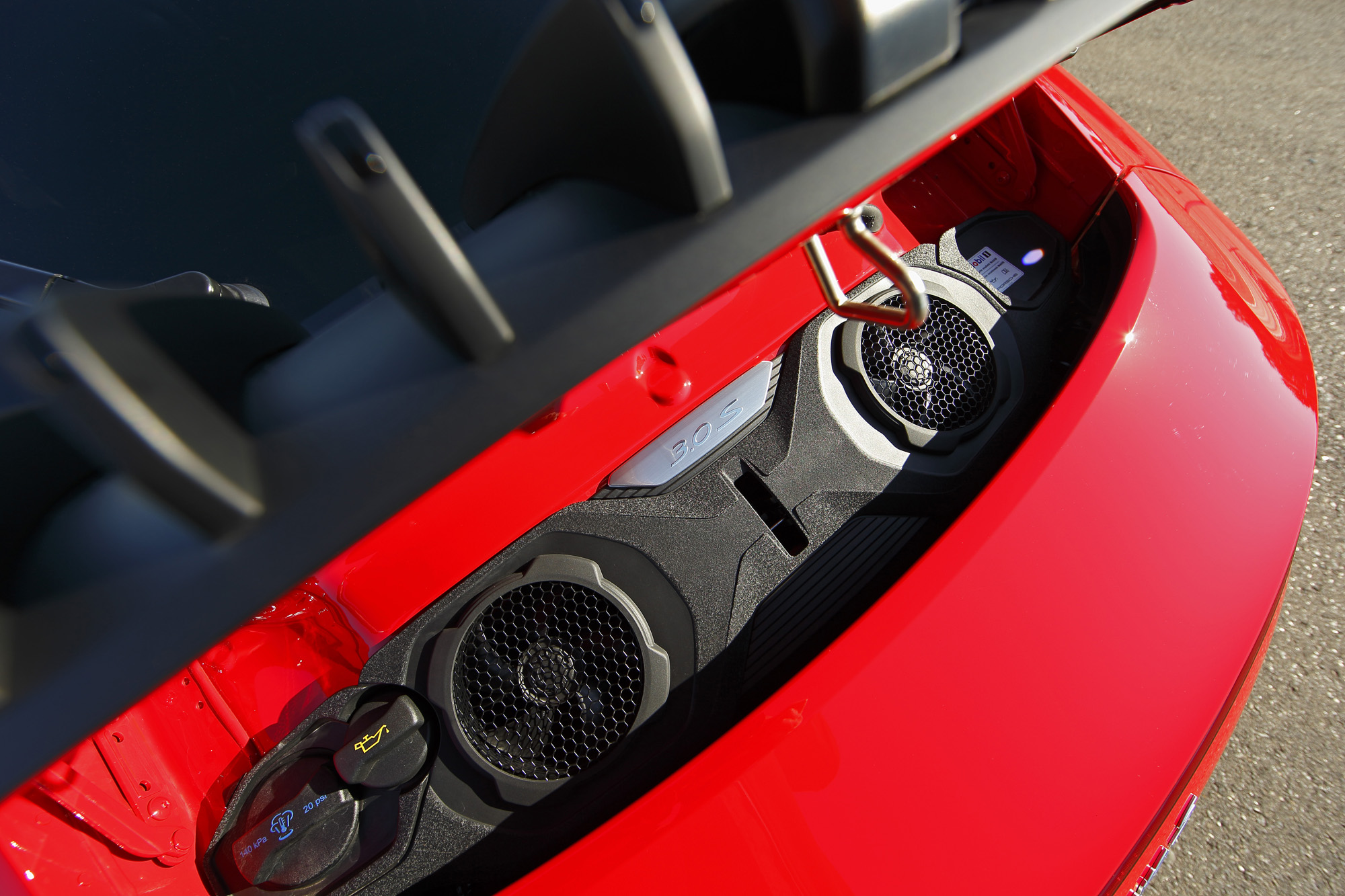
The intercoolers have moved to a more efficient position, right under the rear spoiler. That spoiler can move into three different positions and guide air more effectively to these units. The downside of that is that the air filters are now where the intercoolers were on the 991, namely tucked right down behind the rear bumper bar, so replacing those will require the rear bar to come off. That’s not going to be cheap.
Crash repairs are also going to be hugely expensive on the 992. The body is joined together in ten different ways that include various welds, plate cinching, adhesive bonding, screwing and riveting. That’s up from seven methods for 991 and four for 997. It also means that there’s a challenge in training authorised repair centres to keep on top of these advanced techniques. The 188m of adhesives used for bonding panels, for example, are stronger than the metals themselves and can only be ground out to repair damaged bonded panels. The aluminium rear quarter panel is the body part you really don’t want to bend. It’s huge, and the pressing weighs just 12kg and is fitted to a laser-defined tolerance of 2/100ths of a millimetre. The 992 is likely to be very strong in a crash though. One particularly neat inclusion are steel hooks that jut out from the bottom of the doors that are clasped when the door is locked and prevent the door riding up over the sills in the event of a side impact.
The all-new MMB platform that underpins the 992 will be shared, albeit with a modified rear section, with the next-gen 718 Boxster and Cayman. Hanging off that are some very trick Bilstein DTX dampers on cars equipped with PASM (Porsche Adaptable Suspension Management) – a box you really do need to tick. This drops the car by 10mm to really hunker over its tyres and the dampers offer 40 percent more compliance in compression at the front axle and 32 percent at the rear.
Brakes? They’re still 350mm front and rear, with the rear rotors increased in width. Six piston callipers grab the front discs and four-pot rears do likewise at the back, and the brake booster is now electrically operated, again from Porsche’s hybrid know-how.
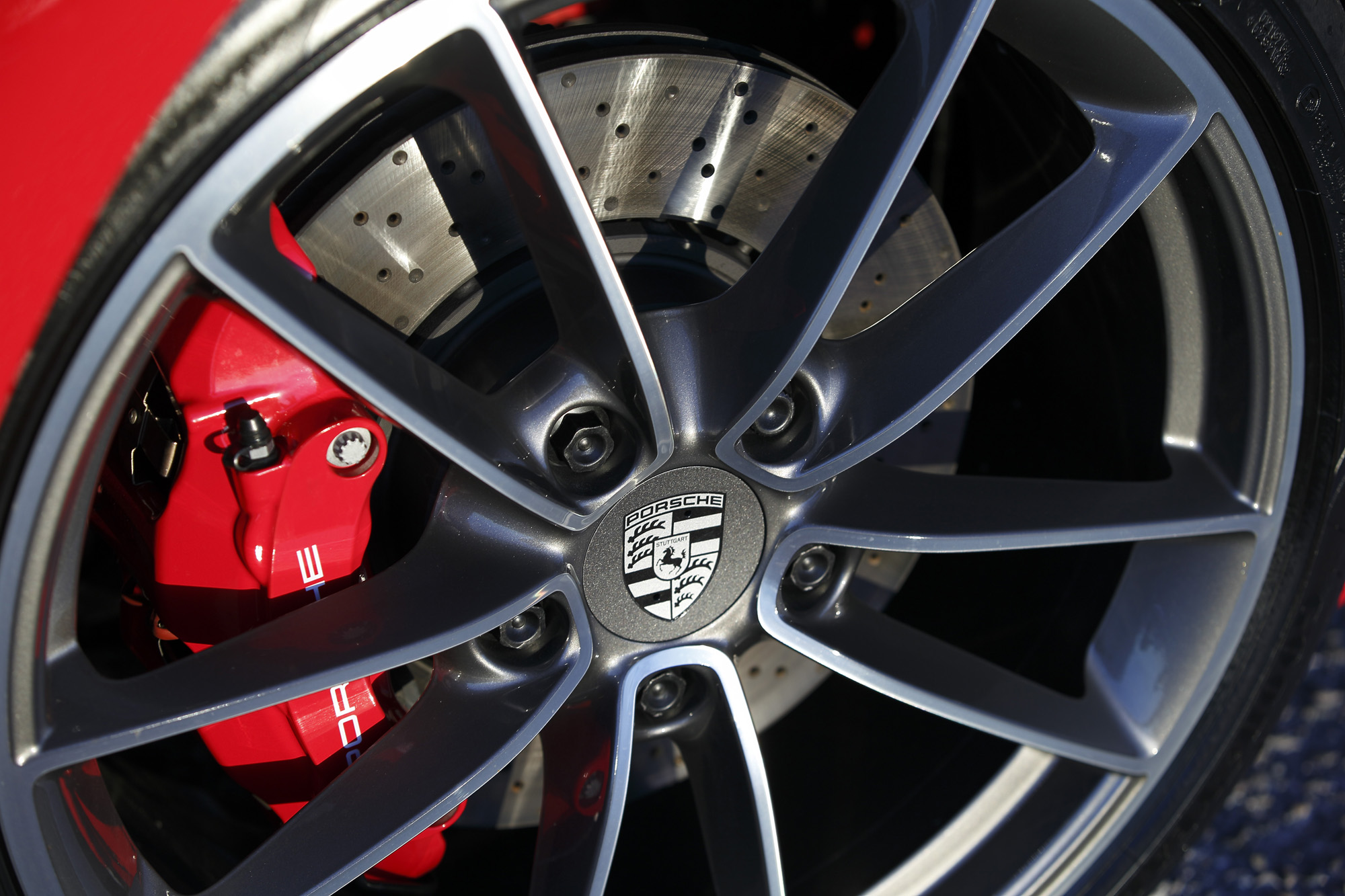
The steering is ten percent more direct and rear-axle steering can also be specified, which replaces the lead acid battery with a lithium-ion unit. The transmission features a shorter first gear and longer seventh and eighth overdrive gears, with the top speed reached in sixth. The casing for the transmission includes real estate for an integrated starter generator, effectively offering a 48v mild hybrid option in due course.
The interior you’ve probably seen and you can doubtless form your own opinion of the aesthetic, but the classic 911 five-clock binnacle remains, the centre one an analogue rev counter flanked on each side by a pair of digital dial faces. The floor of the car has been modified so that the driver can sit lower. This means that despite the car only being 4mm taller than before, there’s another 8mm of headroom. I’m 6’4” and easily fit with a crash helmet on, and that’s in a sunroof car. Remarkable. The frunk has also become more useful with the tool kit not as obtrusively integrated.
Humility isn’t always a quality we’ve come to expect from Porsche, but it’s absolutely fascinating that while the 911 is still the star in its firmament, its engineering team has borrowed stacks of ideas from other wares in the range to better the car.
Prod the knurled metal gear selector into drive, twist the wheel-mounted dial into Sport Plus and we head out on track at The Bend. A revised exhaust and the firmer engine mounts mean that the noise pathways through the car are, let’s say, more direct than the 991 Carrera. The acoustically dampened sound of the turbocharged 991 has given way to a freer breathing 992. It sounds glorious when you open the taps. Not as glorious as the GT3 lead cars guiding us round the circuit, but with a great bass tone overlaid by a breathier more authentically 911 sound. You get some crackles on the overrun too. You’ll love it.
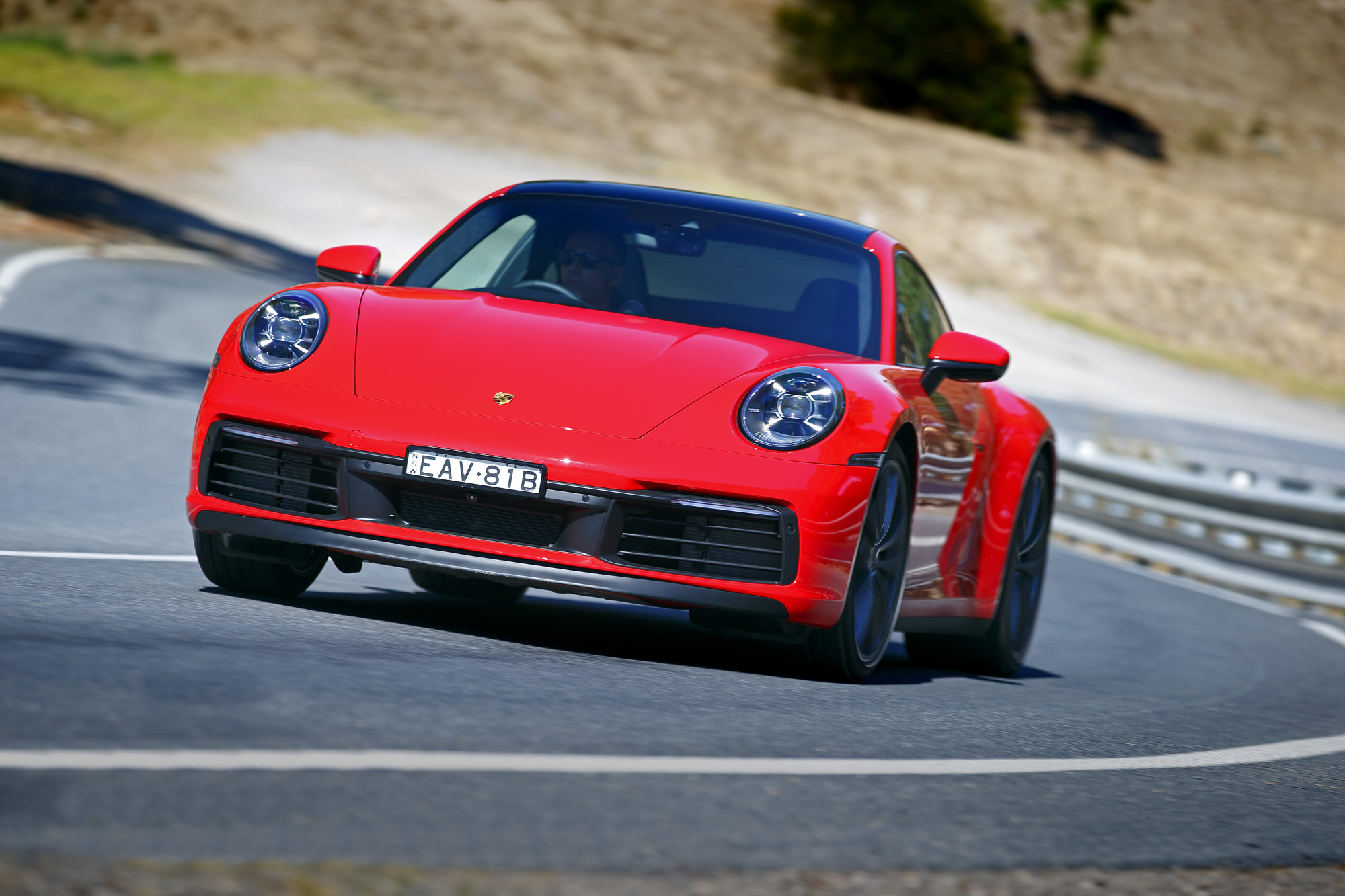
The steering’s sharp without being darty, although I’m not totally convinced of the benefits of the rear steer option. Body control is excellent, although a mid-corner throttle lift still sees the nose duck and bob in time-honoured 911 fashion. The cars at The Bend are all riding on Goodyear Eagle F1 tyres, which is an unusual choice for a 911, but tyre options from Pirelli and – preferably – Michelin are also available. For the first time in a 911, the fitment is staggered, with 20-inch rubber up front and 21s at the back.
Traction is predictably crushing, with the Carrera 4S offering even better purchase out of tight corners. It always sends some traction to the front, but it’s often using more than the 991. A fully electronic multiplate clutch (tech borrowed yet again from hybrids) is linked to an open diff on the front axle, and I reckon the implementation is so unobtrusive that it could well be the pick for demanding drivers. There’s a 50kg weight impost for sending drive to the front axle too, but in bad weather it gives the 992 another level of ability.
That adverse weather ability is also helped by the new Wet Mode function. This uses microphones in the front wheel arch to detect the frequency of water, ice or snow and then dampens a lot of the car’s responses for added traction and yaw stability. The engine’s torque ramping is flattened, the transmission’s shifting strategy is modified, traction and ESC modes are altered, the ABS threshold is lowered, more torque is directed to the front axle, and there’s a reduced degree of locking to the diffs to prevent plough understeer. It’s all very clever and if you can lose directional stability in a 911 with Wet Mode engaged, you’re doing something very special indeed.
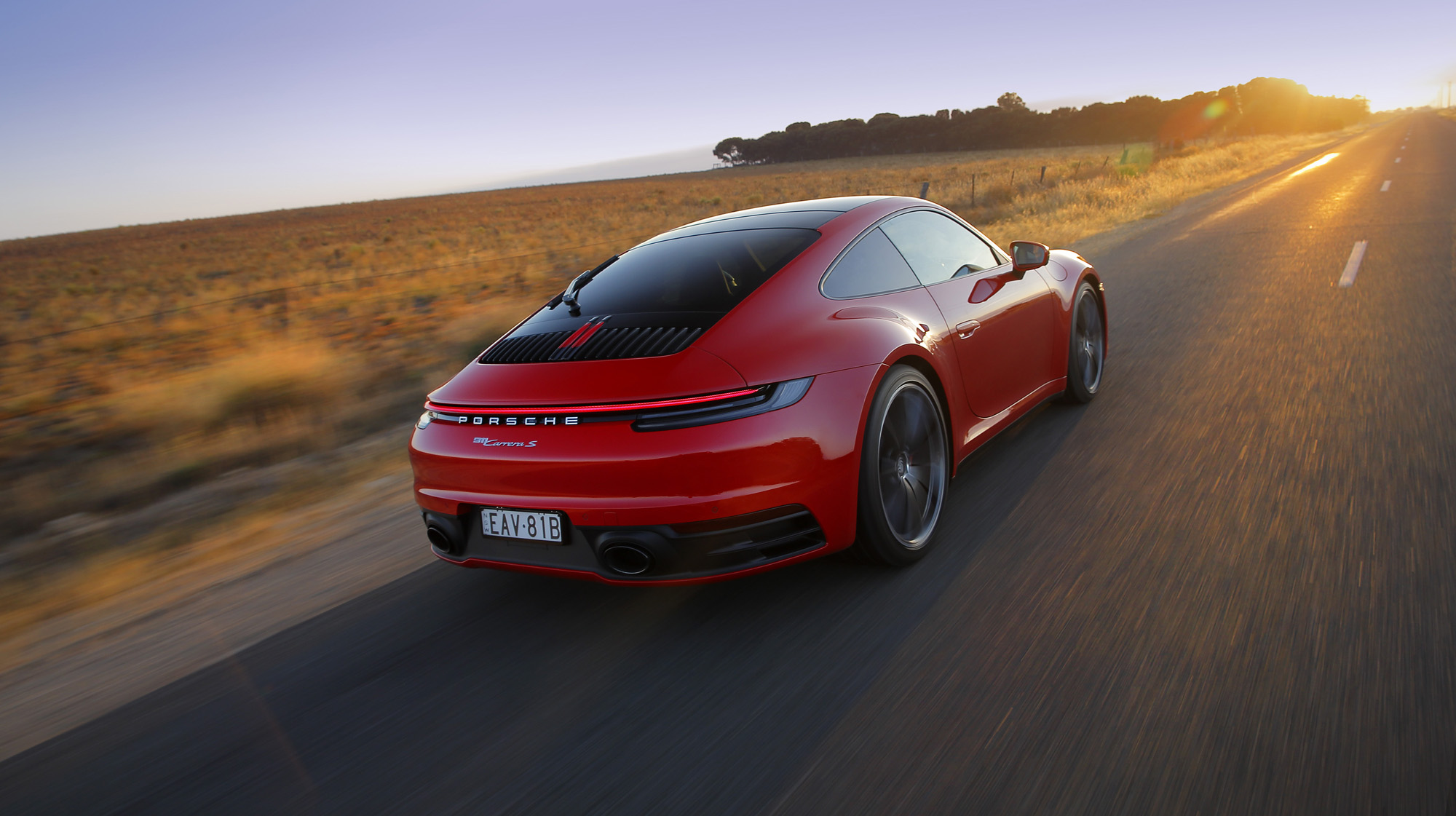
The combination of better steering, improved rear end purchase, bigger tyres, better brakes and improved control of its masses means that the 911 Carrera S offers the driver so many options on track. You can back it into one of the big hairpins on the brakes and the ESC in its looser Sport setting gives you loads of leeway before it decides you’ve run out of talent. Even on a track as huge, wide and, in some places, featureless as The Bend it still feels hugely rapid. On narrow roads, it’s as quick and composed as you’ll ever need a road car to be. About the only flaw in its dynamic makeup is that the extra front overhang means that it can be fairly easy to ground the nose on even innocuous road imperfections.
PORSCHE 911 CARRERA S VS RIVALS
Audi R8, Mercedes AMG GT, Nissan GT-R
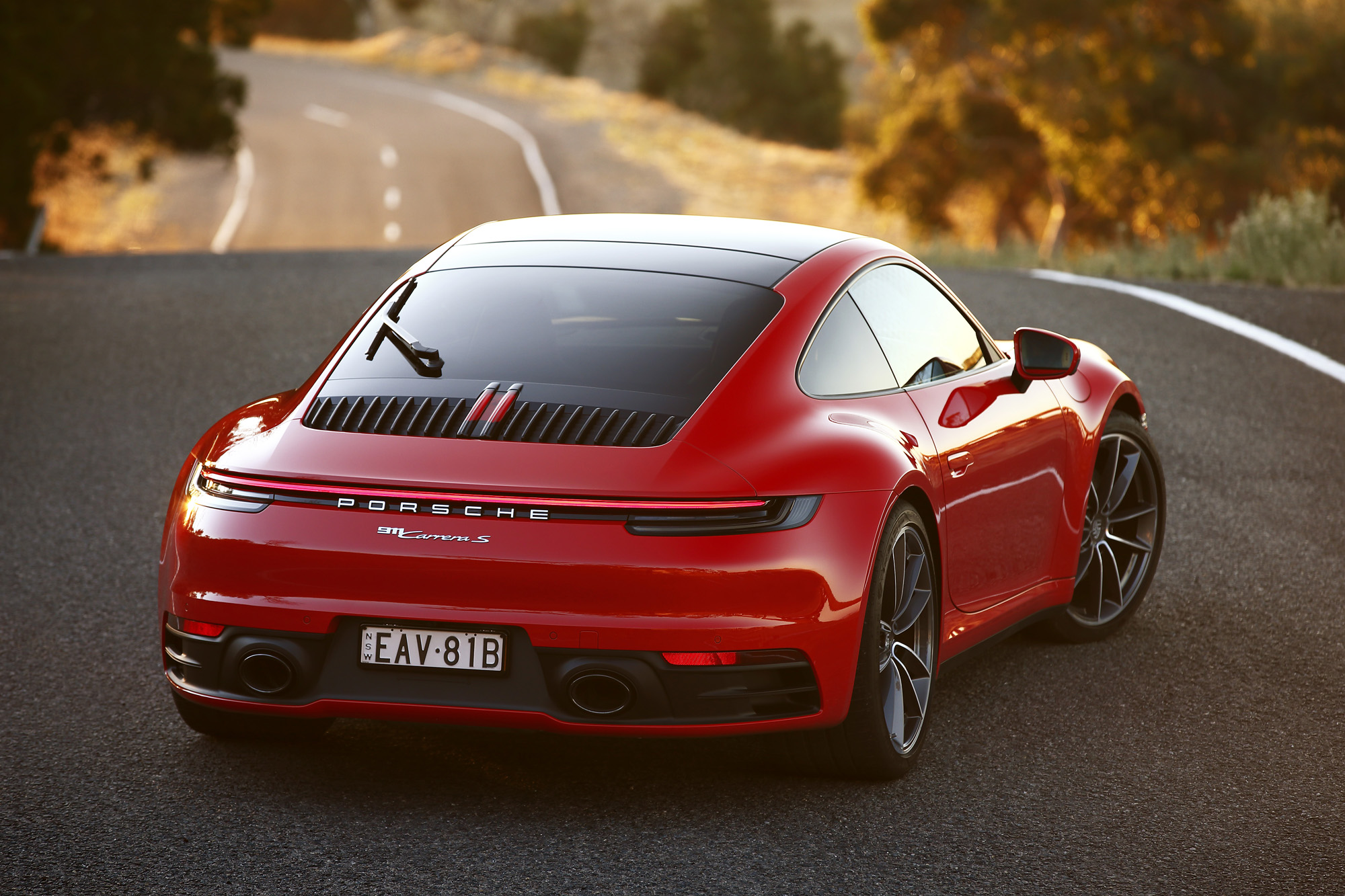
PORSCHE 911 CARRERA S PRICE AND SPECS AUSTRALIA
Model: Porsche 911 Carrera S Engine: 2981cc flat-six bi-turbo, dohc, 24v Max power: 331kW @ 6500rpm Max torque: 530Nm @ 2300-5000rpm Transmission: 8-speed dual-clutch auto, rear-wheel drive Weight: 1515kg 0-100km/h: 3.7 sec (3.5sec w/ Sport Chrono option pack) Economy: 9.5L/100km (combined) Price: $265,000 On sale: Now


